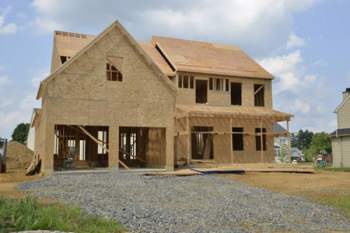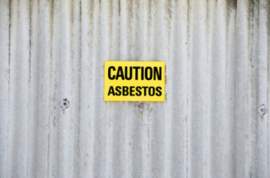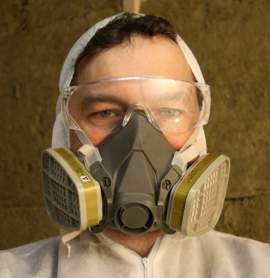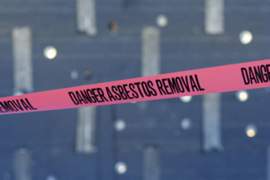
Where is Asbestos in my Home

Must Read
Asbestos Defined:
The United States Environmental Protection Agency defines asbestos as a mineral fiber that is commonly used in a variety of building construction materials for its fire-retardant and insulating properties. Because of the mineral’s fiber strength, asbestos was widely used to bolster a number of manufactured goods, including buildings materials (floor tiles, ceiling tiles, roofing shingles, cement products and paper products), friction materials (automobile clutches, brakes and transmission parts), packaging, coatings, gaskets and fabrics.
When asbestos-containing particles are disturbed or damaged by repair, remodeling or demolition practices, microscopic particles propel into the air. These particles, which are carcinogenic in nature, become susceptible to inhalation. When inhaled, the fibers pose significant long-term health problems.
Prolonged exposure to asbestos fibers greatly increases your risk of developing lung disease. This risk is augmented by smoking and in general, the greater the exposure, the greater the chance of developing harmful side effects. Common asbestos-disease symptoms will take several years to become tangible. If you have worked with asbestos in the past it is essential that you visit a physician to undergo diagnostic or imaging tests. Early detection is typically the only means to combat asbestos-related cancers.
Exposure to airborne asbestos fibers increases the chances of developing cancers because the fibers stick to the lung lining and eat away at its protective tissues. Prolonged exposure to asbestos will increase the amount of fibers in the lungs. Fibers embedded in the lungs, over time, cause serious lung disease, including mesothelioma, lung cancer or asbestosis.
Three of the primary health effects associated with exposure to asbestos filaments includes the following:
Lung Cancer: This disease is the case of the largest number of asbestos-related deaths. Individuals who work in the milling, manufacturing or mining of asbestos, or those who use the deadly mineral and its products face a greater risk of developing lung cancer than the general population. Common symptoms found in lung cancer patients are coughing and a distinct change in breathing. Other symptoms will include: persistent chest pains, anemia, hoarseness and shortness of breath.
Mesothelioma cancer: This is a rare form of cancer that is typically found in the lining of the lungs, chest, heart and abdomen. Mesothelioma cancer is directly linked to asbestos exposure. This disease, because of its slow-developing nature and innocuous cellular structure, will not show up until 30-50 years following the patient’s first exposure to asbestos fibers. Treatment for mesothelioma cancer is dependent on when the disease is located. Unfortunately, because of the aforementioned characteristics, the disease is rarely detected before proliferation occurs. When the disease spreads beyond its point of origin, mesothelioma is deemed inoperable. Advanced stage mesothelioma, therefore, may only be mitigated through the administration of palliative treatment methods, such as radiation, chemotherapy and/or minor surgery. If a patient is lucky enough to secure an early diagnosis for mesothelioma cancer, the individual may undergo curative treatment options that aim to extract the cancer from the body.
Asbestosis: This is a serious, long-term non-cancer disease of the lungs. Asbestosis is caused by inhaling the mineral’s deadly particles that irritate lung tissues, ultimately leading to a mass build-up of scar tissue. This scarring makes it difficult for oxygen to pass through to the blood. Common symptoms associated with asbestosis include: crackling sound in the lungs while inhaling, shortness of breath and chest pains. There is no effective treatment for this debilitating disease.
Where may Asbestos be in My Home?
The Environmental Protection Agency (EPA) states that most products made today do not contain asbestos fibers. Those few products produced that still contain asbestos could be inhaled and are thus required to be labeled as such. However, until the late 1970’s, several types of insulation materials and building products used in home construction contained asbestos. The Environmental Protection Agency of the United States Federal Government lists the following products that are likely to have contained asbestos fibers in the past and the conditions that make these fibers most susceptible to becoming airborne:
• Boilers, Steam Pipes and Furnace Ducts may be insulated with asbestos blankets or asbestos paper tapes. These asbestos materials may perpetuate the release of asbestos fibers, particularly if the products are repaired, damaged or removed improperly
• Asbestos fibers may be found in resilient floor tiles (this product may contain asphalt, rubber and/or vinyl asbestos). Asbestos may be found in the backing on Vinyl Sheet Flooring and/or adhesives used for installing floor tiles. Sanding these tiles can perpetuate the release of asbestos fibers. So any sanding or scraping done on the backing of sheet flooring during abatement may release asbestos fibers.
• Millboard, cement sheets and paper used for insulation around wood-burning stoves and/or furnaces may contain asbestos fibers. Removing or repairing appliances may release asbestos fibers. So any tearing, cutting, drilling, sawing or sanding insulation may cause the release of asbestos fibers.
• Door gaskets in wood stoves, furnaces and coal stoves may contain asbestos. Worn seals may increase the risk of airborne asbestos during use.
• Decorative or soundproofing materials sprayed on ceilings and/or walls may contain asbestos fibers. Crumbly, fragmented, water-damaged or loose materials may release asbestos fibers. So drilling, will sanding or scraping the material is strongly discouraged.
• Joint and patching compounds for ceilings and walls and textured paints may contain asbestos fibers. Scraping, sanding or drilling these surfaces perpetuates the release of asbestos fibers
• Asbestos shingles, siding and cement roofing may contain asbestos fibers. These common residential products are not susceptible to the release of asbestos fibers when cut, drilled or sawed.
• Artificial embers and ashes that are sold for use in gas-fired fireplaces may contain asbestos fibers. Moreover, other aged household products, including fireproof gloves, ironing board covers, stove-top pads and certain types of hairdryers may contain asbestos fibers.
• Automobile clutch facings, gaskets, linings and brake pads may contain asbestos fibers.
• Asbestos fibers may be found in siding shingles and some roofing materials—these products may contain asbestos cement.
• Residential homes built between 1930 and 1950 are likely to use asbestos as insulation
• Wall and attic insulation produced using vermiculite ore, particularly ore that was produced in a Libby, Montana mine is likely to contain asbestos fibers. This type of asbestos was mined in Libby, Montana between the 1920s and 1990. Prior to the closing of these mines in 1990, a bulk of the world’s supply of vermiculite asbestos came from Libby, Montana. These mines possessed a natural deposit of asbestos which caused the vermiculite to become contaminated with asbestos.
• Asbestos products may be present in patching and textured pain compounds used on ceiling and wall joints. Use of asbestos in this fashion was banned in the late 1970’s.
• Embers and artificial ash sold for use in gas-fired fireplaces are likely to contain asbestos compounds.
• Asbestos fibers may be found in some vinyl floor tiles and the backing on adhesives and vinyl sheet flooring
• Asbestos in the home is likely in floors and walls around wood burning stoves; these products may be protected with asbestos cement sheets, millboard and/or asbestos paper
• Asbestos in the home is likely in coal and oil furnaces and/or door gaskets. These products may have been fortified with asbestos insulation.
• Steam and hot water pipes—particularly in older homes—may be coated with asbestos materials or covered with asbestos tape and/or asbestos blankets.
What Should I Do About Asbestos in My Home?
If your home contains any of the above-listed materials, or if you simply think that asbestos may be in your home, don’t panic. Typically the best thing you can do is avoid touching the asbestos materials; if the asbestos material is in good condition, you should leave it alone. Any project that involves disturbing the asbestos will greatly increase the chance of the asbestos becoming airborne. In general, the primary goal regarding asbestos in your home is to limit the risk of airborne asbestos. Leaving good-standing asbestos alone, by avoiding removal, renovation or demolition projects, is the best way to decrease this risk.
In a general sense, asbestos materials in good condition will not release asbestos fibers into the air. If you suspect materials in your home are susceptible to containing asbestos you must suspect these products regularly. Remember, don’t touch these products, but look for signs of damage or wear, including all abrasions, tears or water damages. Any asbestos material that is damaged may release fibers. This is particularly true if you perpetually disturb the product by rubbing, handing or hitting it or if it is exposed to chronic vibrations or disruptions in air flow.
In some cases, the best way to deal with slightly damages asbestos materials is to limit access to the area and not to disturb or tough cit. Any discarded damages or worn asbestos materials must be discarded by an asbestos professional. Be sure to check with your local health, environmental or other government officials to find out proper disposal and/or handling procedures.
If your asbestos material in your home is beyond slightly damaged, or if you are planning to make changes in your home that may disturb asbestos, the hiring of an asbestos professional is mandatory. For example, before having your house renovated or remodeled you must inspected what asbestos materials are present in the home and subsequently hire an asbestos professional to gauge whether abatement procedures are necessary.
How do I Identify Materials that Contain Asbestos in my Home?
In most cases, you will not be able to tell whether a material contains asbestos simply by looking at it. If you are in doubt, you must treat the material as if it contains asbestos or have the material sampled and analyzed by a qualified asbestos professional. An asbestos professional will take multiple samples of the targeted product for analysis—these individuals will know what to look for and apply various procedures to ensure the containment of asbestos particles.
If done incorrectly, the sampling process can yield increased risks, when compared to simply leaving the asbestos product alone. Taking samples of the asbestos is not suggested. Asbestos containing materials that are in stable or good condition and will not be disturbed in the future—from remodeling, renovation or demolition projects—should be left unharmed. Only materials that are damaged or will be disturbed should be taken for sample testing.
How do I Manage my Asbestos Problem?
If the asbestos materials in your home is stable, in good shape and will not be disturbed in the future you must not do a thing! If your asbestos will pose a problem in the future, there are two types of basic correction procedures that may be undertaken: removal and repair.
Asbestos repair will typically involve either covering or sealing asbestos materials:
• Sealing asbestos materials involves treating the material with a sealant that may either bind the asbestos fibers together or coat them so the fibers are not released. Furnace, pipe and boiler insulation may sometimes be repaired in this manner. This type of asbestos repair must be undertaken only by an asbestos professional—these individuals are licensed and professionally trained to safely handle asbestos.
• Enclosing (covering the asbestos) involves placing something over or around the asbestos material to prevent the release of fibers. Any exposed insulating asbestos pipe may be covered with protective jackets or wraps.
In any type of asbestos repair, the asbestos remains in place. Asbestos repair is typically cheaper than removal; however, it may require later removal of asbestos, if necessary, costly or more complex. Asbestos repairs may either be minor or major in nature.
Do’s and Don’ts for the Homeowner Dealing with Asbestos Fibers:
• You should keep activities to a minimum in any area that has damaged asbestos materials or any materials that contain asbestos
• You should take every precaution to avoid damaging asbestos materials
• You should have all major asbestos repair and removal projects conducted by asbestos professionals who are trained and qualified in handling the material. It is highly recommended that minor repairs and asbestos sampling should be done by asbestos professionals.
• You should never sweep, dust or vacuum debris that may contain asbestos fibers
• You should never use brushes on power strippers or abrasive pads to strip wax from asbestos flooring materials. You should also never use a power stripper on dry floors.
• You should never sand or attempt to level asbestos backing or flooring. When an asbestos flooring project is required, you should install new floor covering on top of it
• You must never track material that could contain asbestos through your home. If you cannot avoid walking through a targeted area, you must have it cleaned with a wet mop. If the hazardous materials are taken from a damaged area or if a large area must be cleaned, you must contact an asbestos professional to do it for you.
All major asbestos repairs must be conducted only by an asbestos professional; these individuals are trained in several methods for the safe handling of asbestos materials. In turn, minor repairs must be conducted by professionals because there is always a risk of asbestos exposure to fibers when asbestos is disturbed. Conducting minor repairs without the aid of an asbestos professional increase the odds of creating a hazard where none previously existed.
Asbestos removal is typically the most expensive method and, unless required by local or state regulations, should be the final option reviewed or considered in the majority of situations. This is because asbestos removal poses the most significant risks of fiber release. However, asbestos removal may be required when remodeling or partaking in major renovations to your home—any project that disturbs the asbestos products—will require an asbestos professional. These professionals are required because asbestos removal is exceedingly complex and must be done only by an asbestos contractor who is specially trained and licensed. Improper removal will increase the health risks to you and your loved ones.
Asbestos can be found in a number of applications in the home. This is because asbestos is versatile and prior to a national ban on asbestos construction materials, the preferred and cheapest option for reliable building material. Not all asbestos in the home is a threat to the occupants, but identifying sources of possible asbestos contamination is critical to making decisions on asbestos abatement or other measures to protect your home from hazardous materials.
Why was asbestos used in building materials?
Asbestos has a number for versatile uses, namely fireproofing. Asbestos used for fire retardant purposes will be silicon based, similar to glass. This helps with fire resistance as these materials will not burn and instead will disintegrate under extreme heat. The asbestos used in the home is usually not pure asbestos, but an asbestos compound. The most typical application involved mixing or encasing the asbestos in Portland cement. The result is a durable and fire safe material that can be used for insulation. You will see this application on pipes and as roofing tiles.
Asbestos has the benefit of being cheap, plentiful and easy to extract. Asbestos is a very soft material that can be easily rendered into a powdered form. Compounds can be formed through the use of powdered asbestos and this is the asbestos material that will be in your home.
Asbestos materials in the wall
Walls are going to have asbestos materials and some of it can be hazardous. Firstly, drywall made prior to the asbestos ban will contain asbestos. This is asbestos mixed into the gypsum plaster and then used as a quick solution to creating walls and ceilings in a structure. Compared to conventional methods of building, drywall was considered an excellent solution to the lengthy amount of time it took to lath and plaster during residential construction. Drywall has a standard shape and consistency, which makes it versatile for construction. Any instance where extra fireproofing was needed in the structure, you can expect asbestos drywall. Asbestos drywall is not typically dangerous unless it is exposed. Asbestos drywall will crumble during a renovation or demolition, so federal guidelines advise certain special precautions be taken to avoid self-contamination. These guidelines become mandatory for all non-residential structures.
In addition to asbestos drywall, you can anticipate the joint compound used to bind the drywall together to also contain asbestos materials. These joint compounds are exceptionally friable, meaning that they are susceptible to breaking down and releasing friable fibers.
Asbestos in the ceiling
Asbestos in the ceiling one of the worse places you can find asbestos in the home. This is due to the fact that most applications of ceiling asbestos are friable. The most common application was popcorn ceilings, which is a spray able application that combined plaster and other materials. Popcorn ceilings were used for quick fire and sound proofing and well as covering faults in construction. The texture that results from the application is pitted and resembles the surface of a popcorn kernel.
Popcorn ceilings are not durable in the slightest and will degrade through age and wear and degrade even faster if broken or disturbed. The friable material will leach asbestos fibers and can potentially sicken those that are exposed to it in the long term. Removal or at least encapsulation should be considered for popcorn ceilings in poor shape.
Asbestos in the floor
You may find asbestos in flooring tiles and this may not be much of a problem. Unless floor tiles are damaged or in exceptionally poor shape, any asbestos contained within the tile are generally not a danger. This is because most asbestos flooring tiles are encased in durable vinyl and other hard plastics. Asbestos can only escape and sicken you when it is directly exposed. Asbestos regulations even allow some asbestos tiles remain in a building during demolition as long as it is not in poor condition. You may have this form of asbestos in your home, but you are best served leaving it alone.
Asbestos in the insulation
These days we have fiberglass insulation and this is the most common insulating fibers used in new construction. Older structures however, will have asbestos fibrous insulation, which is potentially very dangerous. The danger derives from the nature of the asbestos, especially since typical insulation is the asbestos wool covered with heavy paper. Once this is disturbed, it will steadily release asbestos fibers and in enclosed spaces, such as attics, the concentration of fibers will be very high and hazardous.
Asbestos on the house
You will also find asbestos on your home in the form of roofing tiles and siding. In terms of roofing, tiles will be composed of friable asbestos encased in a compound of tar and other materials. In addition, the tiles may be secured to the roof with asbestos felt, which will have insulating properties, although being incredibly friable when exposed. Portland cement siding, which is largely defunct, will be found on older homes and these siding tiles may contain friable asbestos.
Should I remove asbestos from my home?
There is no law that explicitly states you must remove asbestos from your home. You are bound by laws that provide for the safe disposal of asbestos containing materials and other statutes that provide penalties for irresponsible abatement. The fact is, most asbestos in the home is not dangerous until there is renovation or demolition taking place.
Self-removal of asbestos containing materials will potentially cause more harm than necessary as since breaching indurate material will cause the mass release of harmful fibers. Asbestos abatement procedure minimizes this risk by mandating adequate protection, filters to trap loose particles and techniques such as wetting friable asbestos to prevent fibers from becoming airborne.
What are my alternatives for asbestos my home?
You can seal asbestos fibers to prevent their escape. This is cheaper than removing all the materials and replacing it with safer alternatives. This is called encapsulation and can be performed by a licensed asbestos contractor.



















